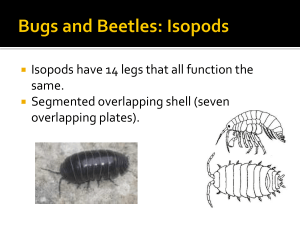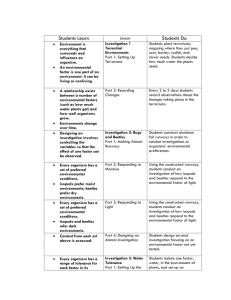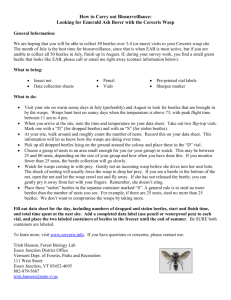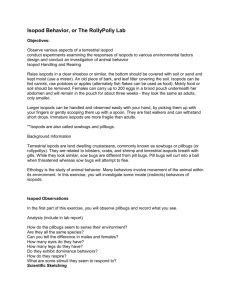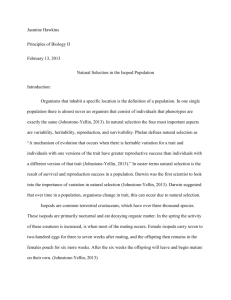Environments - SPECK-8
advertisement
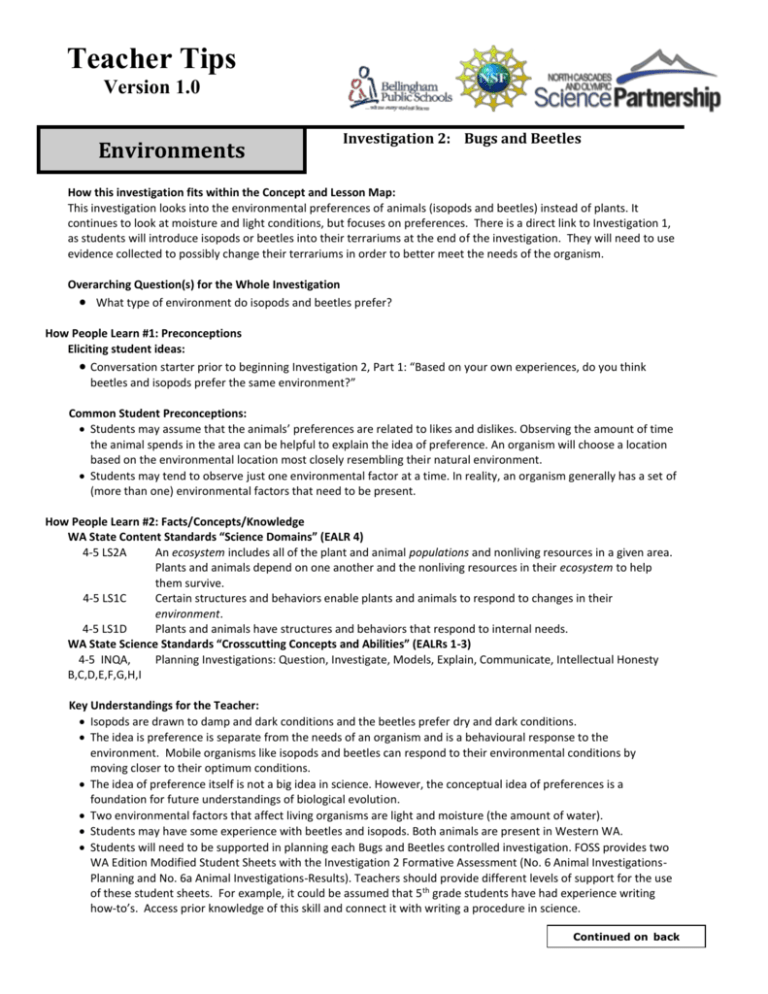
Teacher Tips Version 1.0 Environments Investigation 2: Bugs and Beetles How this investigation fits within the Concept and Lesson Map: This investigation looks into the environmental preferences of animals (isopods and beetles) instead of plants. It continues to look at moisture and light conditions, but focuses on preferences. There is a direct link to Investigation 1, as students will introduce isopods or beetles into their terrariums at the end of the investigation. They will need to use evidence collected to possibly change their terrariums in order to better meet the needs of the organism. Overarching Question(s) for the Whole Investigation What type of environment do isopods and beetles prefer? How People Learn #1: Preconceptions Eliciting student ideas: Conversation starter prior to beginning Investigation 2, Part 1: “Based on your own experiences, do you think beetles and isopods prefer the same environment?” Common Student Preconceptions: Students may assume that the animals’ preferences are related to likes and dislikes. Observing the amount of time the animal spends in the area can be helpful to explain the idea of preference. An organism will choose a location based on the environmental location most closely resembling their natural environment. Students may tend to observe just one environmental factor at a time. In reality, an organism generally has a set of (more than one) environmental factors that need to be present. How People Learn #2: Facts/Concepts/Knowledge WA State Content Standards “Science Domains” (EALR 4) 4-5 LS2A An ecosystem includes all of the plant and animal populations and nonliving resources in a given area. Plants and animals depend on one another and the nonliving resources in their ecosystem to help them survive. 4-5 LS1C Certain structures and behaviors enable plants and animals to respond to changes in their environment. 4-5 LS1D Plants and animals have structures and behaviors that respond to internal needs. WA State Science Standards “Crosscutting Concepts and Abilities” (EALRs 1-3) 4-5 INQA, Planning Investigations: Question, Investigate, Models, Explain, Communicate, Intellectual Honesty B,C,D,E,F,G,H,I Key Understandings for the Teacher: Isopods are drawn to damp and dark conditions and the beetles prefer dry and dark conditions. The idea is preference is separate from the needs of an organism and is a behavioural response to the environment. Mobile organisms like isopods and beetles can respond to their environmental conditions by moving closer to their optimum conditions. The idea of preference itself is not a big idea in science. However, the conceptual idea of preferences is a foundation for future understandings of biological evolution. Two environmental factors that affect living organisms are light and moisture (the amount of water). Students may have some experience with beetles and isopods. Both animals are present in Western WA. Students will need to be supported in planning each Bugs and Beetles controlled investigation. FOSS provides two WA Edition Modified Student Sheets with the Investigation 2 Formative Assessment (No. 6 Animal InvestigationsPlanning and No. 6a Animal Investigations-Results). Teachers should provide different levels of support for the use of these student sheets. For example, it could be assumed that 5 th grade students have had experience writing how-to’s. Access prior knowledge of this skill and connect it with writing a procedure in science. Continued on back Teacher Tips Version 1.0 Here is a possible suggestion of how to gradually release responsibility to the student for writing about a controlled investigation as the students continue on with Parts 3 and 4. The teacher models how to plan Part 2: Responding to Moisture via a teacher demonstration. This will be the standard Bugs and Beetles procedure. As the teacher models, students copy the procedure into their science notebooks or onto the student sheets. In Part 3: Responding to Light, students should be given more responsibility in planning the investigation. The teacher should post the previous investigation and refer students back to it in their science notebooks. In planning the new investigation, student groups use the previous standard investigation to change or add based on the new focus question. Groups may use whiteboards or a large piece of paper to write their drafts. Each group can share their plans with the class and get feedback via a discussion. Not all group plans will be exactly the same, but should be somewhat similar. When plans are complete, students copy them into their science notebooks or onto the student sheets. Part 4: Designing an Animal Investigation allows students to have greater independence and choice in designing an investigation. While some students may be ready for taking ownership of the entire process, it should not be assumed that all students are totally independent. The teacher should provide continued support and scaffolding for these students. How People Learn #3: Metacognition Metacognition: How did my thinking change? What caused the change? How did I come to believe this? After Part 3: Student science notebook reflection, “How do the environmental factors in our terrarium match the preferences for beetles and/or isopods? What changes could we make to our terrariums to better meet the needs of isopods and/or beetles?” Allow them to use words, pictures, labeled diagrams. When students finish individual reflections, ask them to share their ideas and make a plan to introduce isopods or beetles into their terrariums after part 4 is complete (in a week or two). Post Assessment science notebook prompt after Part 4: “Based on the evidence from our 4 animal investigations, explain how the environmental conditions in your terrariums match the preferences of beetles and/or isopods? Evidence of Student Understanding: Part 3 of Student Sheet 6: Conclusion: Animal Investigations or equivalent prompt in science notebook. Use provided rubric to analyze. ________________________________________________________________________________________________________ Additional Information Materials and Student Management Building of runways in Part 1 can be done by a few students ahead of time instead of using class time. Order beetles and isopods 4-6 weeks ahead of time. Contact: Linda Pollino at Carl Cozier (refurbishes kits). Beetles should be placed in a large terrarium type container with a couple inches of bran or oatmeal cereal. Put dry crinkled paper towels sheets on top to provide a hidden, climbing environment. Delta Education also suggests a couple chunks of apple. Isopods should be placed in a terrarium containing most/wet soil and woody debris. A couple slices of apple are also recommended. Make sure these environments are kept out of the view of students, as to not give them clues to their investigation purpose. Investigations 2 and 3 both require potting soil that is totally dry – spread potting soil out on newspaper to dry for two days in order to have a ready supply. Timing Considerations Part 4: Groups will have various time frames for their own investigations. Groups may also need additional materials. Helpful Resources and Bibliography: Atlas of Science Literacy, V2. American Association for Advancement of Science. P32-33. Washington Edition: Assessment Environments, Grade 5 version (Updated formative assessment packet, 2006)
